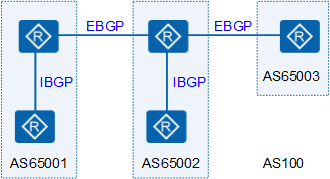BGP Confederation
- Original IBGP attributes are retained, including the Local_Pref attribute, MED attribute, and Next_Hop attribute.
- Confederation-related attributes are automatically deleted when being advertised outside a confederation.
Therefore, the administrator does not need to configure the rules for filtering information such as sub-AS numbers at the egress of a confederation.
As shown in Figure 1, AS 100 is divided into three sub-ASs after a confederation is configured: AS65001, AS65002, and AS65003. The AS number AS 100 is used as the confederation ID. In Figure 1, to implement route transmission and packet forwarding, 10 IBGP connections are required if a logical full mesh is used. If the confederation is used, only two IBGP connections and two EBGP connections are required. Therefore, using the confederation simplifies the device configuration and reduces the network and CPU burden. In addition, BGP devices outside AS 100 only know the existence of AS 100 but not the confederation within AS 100. Therefore, the confederation does not increase the CPU load.
Comparisons Between a Route Reflector and a Confederation
Table 1 compares a route reflector and a confederation in terms of the configuration, device connection, and applications.
| Route Reflector | Confederation |
|---|---|
| Retains the existing network topology and ensures compatibility. | Requires the logical topology to be changed. |
| Requires only a route reflector to be configured because clients do not need to know that they are clients of a route reflector. | Requires all devices to be reconfigured. |
| Requires full-mesh connections between clusters. | Does not require full-mesh connections between sub-ASs of a confederation because the sub-ASs are special EBGP peers. |
| Applies to medium and large networks. | Applies to large networks. |
